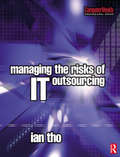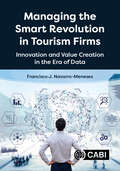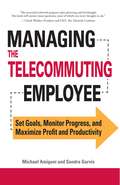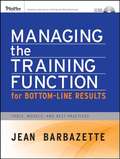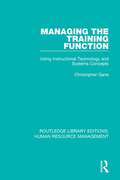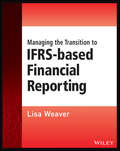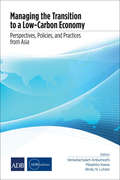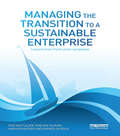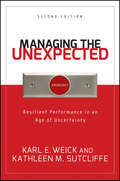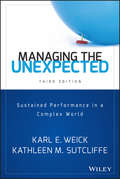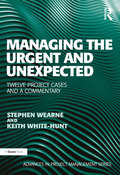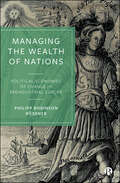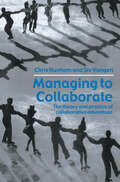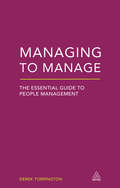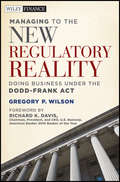- Table View
- List View
Managing the Risks of Extreme Events and Disasters to Advance Climate Change Adaptation
by Christopher B. Field Vicente Barros Thomas F. Stocker Qin DaheThis Intergovernmental Panel on Climate Change Special Report (IPCC-SREX) explores the challenge of understanding and managing the risks of climate extremes to advance climate change adaptation. Extreme weather and climate events, interacting with exposed and vulnerable human and natural systems, can lead to disasters. Changes in the frequency and severity of the physical events affect disaster risk, but so do the spatially diverse and temporally dynamic patterns of exposure and vulnerability. Some types of extreme weather and climate events have increased in frequency or magnitude, but populations and assets at risk have also increased, with consequences for disaster risk. Opportunities for managing risks of weather- and climate-related disasters exist or can be developed at any scale, local to international. Prepared following strict IPCC procedures, SREX is an invaluable assessment for anyone interested in climate extremes, environmental disasters and adaptation to climate change, including policymakers, the private sector and academic researchers.
Managing the Risks of IT Outsourcing
by Ian ThoThis book shows IT managers how to identify, mitigate and manage risks in an IT outsourcing exercise. The book explores current trends and highlights key issues and changes that are taking place within outsourcing. Attention is given to identifying the drivers and related risks of outsourcing by examining recently published and existing concepts of IT outsourcing. Founded on academic theory and empirical and quantitative information, this book:* Incorporates the complete risk identification and mitigation life cycle* Highlights the concept of core competency * Looks at motivating factors and working relationships of the buyer and supplier* Provides background to understand the risks as a result of ‘human factors’ as defined by the agency theory* Reviews the areas of risk that influence the decision to outsource the IT function* Examines the forces that determine the equilibrium in the risk profiles for the buyer and supplier
Managing the Smart Revolution in Tourism Firms: Innovation and Value Creation in the Era of Data
by Dr Francisco Navarro-MenesesSmart Technologies are revolutionizing tourism, as they promise to change the way tourists behave and how companies interact with them and generate profits. The increasing availability of real-time data in combination with advanced machine learning techniques, artificial intelligence and business analytics, to name but a few, will transform the tourism industry forever and in unthinkable ways. The degree of sophistication achieved by Smart Technologies and the speed with which transformations are taking place means that those people lacking a relevant digital background may lag behind, therefore being unable to take advantage of the opportunities offered by the data economy and fully benefit from its applications. This practical book explains the key ideas that tourism practitioners and decision-makers must know to understand Smart Technologies, and the management principles supporting them. The contents: · Include real-life cases to illustrate to the reader the true dimension of the "smart" phenomenon and the new frontiers that are yet to open in the coming years · Bring together the knowledge and experience of leading experts from the academia, tourism sector and technology companies, who reveal, in a unified way, the fundamental points your organization must consider in the path towards being smarter · Create a practical knowledge tool that allows getting the most out of Smart Technologies, its products and future trends, while learning how to make them a competitive tool, and avoid being left behind · Features full colour figures and photographs The book will be a vital resource for Tourism practitioners, strategic planners and policy makers as well as students of tourism marketing, management and technology
Managing the Strategy Development Process
by Clayton M. Christensen Michael E. RaynorA crucial question that many managers forget to ask about strategy when building a new business relates to the process of strategy formulation that the venture's management team will use to develop and implement a winning plan. This chapter offers two different processes of strategy development and presents a circumstance-based theory to help managers determine which of the processes will be the most reliable source of strategic insight at different stages of business development.
Managing the Telecommuting Employee
by Michael Amigoni Sandra GurvisA bigger and bigger part of the workforce is telecommuting. And managers need new skills to get the most out of this increasingly far-flung staff. This indispensable guide includes case studies, checklists, and sample forms and charts. It shows managers how to use teleconferencing technology to communicate with distanced workers, make the best use of scheduling software to monitor productivity, and even end the arrangement if it's not working. One of the best ways for companies to save money in lean times is to send their employees home to work. But that requires a different kind of workforce and a different kind of management. This book shows how to make the long-distance relationship work for everyone!
Managing the Telecommuting Employee: Set Goals, Monitor Progress, and Maximize Profit and Productivity
by Michael Amigoni Sandra GurvisA bigger and bigger part of the workforce is telecommuting. And managers need new skills to get the most out of this increasingly far-flung staff. This indispensable guide includes case studies, checklists, and sample forms and charts. It shows managers how to use teleconferencing technology to communicate with distanced workers, make the best use of scheduling software to monitor productivity, and even end the arrangement if it's not working.One of the best ways for companies to save money in lean times is to send their employees home to work. But that requires a different kind of workforce and a different kind of management. This book shows how to make the long-distance relationship work for everyone!
Managing the Training Function For Bottom Line Results
by Jean BarbazetteThis book presents time saving strategies, tactics, and a host of job aids to get the best result from the corporate learning function. It will serve both as a must-have reference tool and as a practical survival guide for workplace learning professionals who face unique challenges in accomplishing their responsibilities. Several strategies and tactics are offered to organize the roles and responsibilities of the training function. There's authoritative advice, too, for managing the function including staff management, communicating expectations, setting the learning agenda, coaching subject matter experts, hiring consultants and vendors, managing content, working with learning portals, setting up and managing a learning resource center, marketing and building internal support for training, and integrating learning into the business.
Managing the Training Function: Using Instructional Technology and Systems Concepts (Routledge Library Editions: Human Resource Management #16)
by Christopher GaneThe effective development of human resources within the organisation is one of the most powerful contributions to the long-term growth and survival of the enterprise. This systematic and practical approach to training principles and practice, first published in 1972, provides a unifying framework as a guide to problem solving and action by executives. This step-by-step account, illustrated by case histories, shows how to apply the principles to analysing and solving varied training problems within organisations. This title will be of interest to managers, executives, and students of business studies and human resource management.
Managing the Transformation: A Case Study--Becoming an Adaptive Enterprise
by Stephan H. HaeckelAlthough the sense-and-respond efforts of early adopters are works-in-progress, their experiences of the concept of adaptive enterprise reveal much about the problems and benefits-expected and unexpected-of the ongoing transformation process. This chapter looks at the case of IBM's Palisades Executive Conference Center to offer insights into the process of developing buy-in and commitment to the adoption of a sense-and-respond model.
Managing the Transition to IFRS-Based Financial Reporting
by Lisa WeaverSince 2005, all EU listed companies have been reporting under IFRS in their group accounts. The UK's Accounting Standards Board is proposing that in the next few years all UK companies, other than the smallest, will move to some form of IFRS-based financial reporting. The US is also undergoing a transition to IFRS, as are many other countries such as India and Japan.This book will cover the most common accounting issues involved in a move to IFRS, and deal with the specific accounting and disclosure requirements in the first year of IFRS reporting. Crucially, however, the book will also focus on how to plan and manage the transition, fully exploring the non-accounting implications based on the experience of companies that have already gone through the transition.The book:Provides a clear summary of the main IFRS accounting requirements which are specific to IFRS transitionFocusses on planning and managing the IFRS transition projectEmphasises the non-accounting implications of IFRS transitionConsiders how to best communicate and educate about the IFRS transitionIncludes case studies of companies that have gone through the IFRS transitionManaging the transition to IFRS-based financial reporting does not focus on any specific country, instead offering advice which can be applied in all jurisdictions. This international appeal, coupled with its holistic approach, makes it the one-stop guide to managing this vital transition.
Managing the Transition to a Circular Economy: Action Plans in the Tourism Sector (SpringerBriefs in Business)
by Virginia Santamarina-Campos Marival Segarra-Oña Ángel Peiró-SignesThis open access book presents an interdisciplinary analysis of the current status of the circular economy in the tourism sector. This book is presented from the perspective of researchers, policymakers, and industry. Specially aimed at companies in the tourism sector, the book offers valuable information in the field of circular economy, promoting the design/redesign of processes and products. The authors emphasize promoting the development and application of new knowledge and technologies to promote innovation in processes, products, services, and business models, promoting public-private collaboration. With contributions from experts representing varied interests throughout the tourism industry, the book encourages the involvement of economic and social agents to raise awareness of current environmental, economic, and technological challenges.
Managing the Transition to a Low-Carbon Economy: Perspectives, Policies, and Practices from Asia
by Masahiro Kawai Venkatachalam Anbumozhi Bindu N. LohaniAsia must be at the center of the global fight against climate change. It is the world's most populous region, with high economic growth, a rising share of global greenhouse gas emissions, and the most vulnerability to climate risks. Its current resource- and emission-intensive growth pattern is not sustainable. This study recognizes low-carbon green growth as an imperative-not an option-for developing Asia.Asia has already started to move toward low-carbon green growth. Many emerging economies have started to use sustainable development to bring competitiveness to their industries and to serve growing green technology markets.The aim of this study is to share the experiences of emerging Asian economies and the lessons learned. The book assesses the low-carbon and green policies and practices taken by Asian countries, identifies gaps, and examines new opportunities for low-carbon green growth.
Managing the Transition to a Sustainable Enterprise: Lessons from Frontrunner Companies
by Mara Francken Rob van Tulder Rob van Tilburg Andrea da RosaIn combining practice and theory, this textbook provides a management perspective on the ‘business case’ for sustainability. Drawing on examples from 20 frontrunner companies located in the Netherlands, it builds upon a unique research project in which CEOs and middle-managers gave access not only to their decision-making process, but also revealed how their perceptions shaped the transition process. This book identifies four different archetypes of business cases and related business models that business students and managers can use to identify phases and related attitudes towards sustainability. The book provides in-depth analysis and insight into: • theoretical concepts and an overview of the relevant literature • the different business cases for sustainability • behavioural characteristics of each phase and the typical barriers between them • more than 70 tipping points • approaches to shaping stakeholder dialogue • effective engagement of stakeholders in each phase of transition • how companies move through the phases towards higher levels of sustainability • insights of employees of the 20 companies whether the business case was really achieved • summary of the interventions which have proved successful in these companies. This book offers students as well as managers of vocational and academic institutions at undergraduate and postgraduate level insight into real-life transition processes towards sustainability.
Managing the Unexpected
by Karl E. Weick Kathleen M. SutcliffeSince the first edition of Managing the Unexpected was published in 2001, the unexpected has become a growing part of our everyday lives. The unexpected is often dramatic, as with hurricanes or terrorist attacks. But the unexpected can also come in more subtle forms, such as a small organizational lapse that leads to a major blunder, or an unexamined assumption that costs lives in a crisis. Why are some organizations better able than others to maintain function and structure in the face of unanticipated change? Authors Karl Weick and Kathleen Sutcliffe answer this question by pointing to high reliability organizations (HROs), such as emergency rooms in hospitals, flight operations of aircraft carriers, and firefighting units, as models to follow. These organizations have developed ways of acting and styles of learning that enable them to manage the unexpected better than other organizations. Thoroughly revised and updated, the second edition of the groundbreaking book Managing the Unexpected uses HROs as a template for any institution that wants to better organize for high reliability.
Managing the Unexpected: Resilient Performance in an Age of Uncertainty
by Karl E. Weick Kathleen M. SutcliffeSince the first edition of 2001 it appears that we are dealing more and more with the unexpected, and not just in the form of news about terrorist attacks. Fires, floods, hurricanes, financial disasters, tornadoes and even the occasional volcano seem to be on the increase, with the result being a constant state of apprehension and, in the case of many organizations, sense of perpetual panic. Weick and Sutcliffe (organizational behavior and psychology, and management and organization, respectively, U. of Michigan Business School) update the text to reflect current conditions, laws, practices and policies as they get managers ready to expect the unexpected and plan accordingly. They admit that in real life everything can go wrong, but they do show models in which the unexpected is part of daily life, such as emergency rooms and airports, and how managers cope. Annotation ©2007 Book News, Inc., Portland, OR (booknews.com)
Managing the Unexpected: Sustained Performance in a Complex World (J-b Us Non-franchise Leadership Ser. #8)
by Karl E. Weick Kathleen M. SutcliffeImprove your company's ability to avoid or manage crises Managing the Unexpected, Third Edition is a thoroughly revised text that offers an updated look at the groundbreaking ideas explored in the first and second editions. Revised to reflect events emblematic of the unique challenges that organizations have faced in recent years, including bank failures, intelligence failures, quality failures, and other organizational misfortunes, often sparked by organizational actions, this critical book focuses on why some organizations are better able to sustain high performance in the face of unanticipated change. High reliability organizations (HROs), including commercial aviation, emergency rooms, aircraft carrier flight operations, and firefighting units, are looked to as models of exceptional organizational preparedness. This essential text explains the development of unexpected events and guides you in improving your organization for more reliable performance. "Expect the unexpected" is a popular mantra for a reason: it's rooted in experience. Since the dawn of civilization, organizations have been rocked by natural disasters, civil unrest, international conflict, and other unexpected crises that impact their ability to function. Understanding how to maintain function when catastrophe strikes is key to keeping your organization afloat. Explore the many different kinds of unexpected events that your organization may face Consider updated case studies and research Discuss how highly reliable organizations are able to maintain control during unexpected events Discover tactics that may bolster your organization's ability to face the unexpected with confidence Managing the Unexpected, Third Edition offers updated, valuable content to professionals who want to strengthen the preparedness of their organizations—and confidently face unexpected challenges.
Managing the Urgent and Unexpected: Twelve Project Cases and a Commentary (Advances in Project Management)
by Stephen Wearne Keith White-HuntSometimes unanticipated threats or opportunities create a situation in which work is required unexpectedly. On these occasions, such urgent and unexpected work demands an instant start, in contrast to the often lengthy processes of investigation, evaluation, development, selection and planning normal in businesses and public services before the start of a project. Managing the Urgent and Unexpected explores what is different managerially if work is unexpected, its implementation is urgent and an immediate start it is required. The authors draw on twelve cases ranging from the launch of the Freeview television system in the United Kingdom to the sifting and removal of the New York World Trade Center pile of debris following the 9/11 terrorist attack. They summarise how the response to each of these events was managed, demonstrate that opportunities may sometimes be created in the face of adversity and suggest how normal organizations can prepare to manage abnormal demands. Urgent and unexpected projects have to be rare in business or government to be economically and socially tolerable. And yet organizations can and should be prepared for the unexpected. The lessons offered here will help private and public organizations plan how to authorize and support future urgent work to take advantage of immediate new business opportunities or to protect or restore systems and services.
Managing the Wealth of Nations: Political Economies of Change in Preindustrial Europe
by Philipp Robinson Rössner‘Commerce and manufactures gradually introduced order and good government,’ wrote Adam Smith in his Wealth of Nations, ‘and with them, the liberty and security of individuals.’ However, Philipp Robinson Rössner shows how, when looked at in the face of history, it has usually been the other way around. This book follows the development of capitalism from the Middle Ages through the industrial revolution to the modern day, casting new light on the areas where premodern political economies of growth and development made a difference. It shows how order and governance provided the foundation for prosperity, growth and the wealth of nations. Written for scholars and students of economic history, this is a pioneering new study that debunks the neoliberal origin myth of how capitalism came into the world.
Managing the Work Situation: A Phenomenological Approach to Organization and Management in a Complex World of Work
by Lars KlemsdalManaging the Work Situation outlines a perspective on how organization and management in the contemporary world of work happens as active everyday accomplishments by workers and managers, facing and handling complex work situations with an excess of expectations.Based on philosophical and sociological phenomenology, notably Jean-Paul Sartre’s and Erving Goffman’s works, the book coins a situation-centric perspective on organization and management, and the concept of ‘situational sensemaking’, as the driving mechanism of organization as well as the focus of management – characterized as ‘situation management’.The book addresses an academic audience with interests in organization and management of work, both theoretically and practically. A prime audience will be (academic and executive) master students in organization and management.
Managing to Change the World
by Alison Green Jerry HauserWhy getting results should be every nonprofit manager's first priority A nonprofit manager's fundamental job is to get results, sustained over time, rather than boost morale or promote staff development. This is a shift from the tenor of many management books, particularly in the nonprofit world. Managing to Change the World is designed to teach new and experienced nonprofit managers the fundamental skills of effective management, including: managing specific tasks and broader responsibilities; setting clear goals and holding people accountable to them; creating a results-oriented culture; hiring, developing, and retaining a staff of superstars. Offers nonprofit managers a clear guide to the most effective management skills Shows how to address performance problems, dismiss staffers who fall short, and the right way to exercising authority Gives guidance for managing time wisely and offers suggestions for staying in sync with your boss and managing up This important resource contains 41 resources and downloadable tools that can be implemented immediately.
Managing to Collaborate: The Theory and Practice of Collaborative Advantage
by Chris Huxham Siv VangenCollaboration between organizations on different continents can raise issues of economic development, health, the environment, risk sharing, supply chain efficiency and human resource management. It is an activity that can touch upon almost every aspect of business and social life. In this notable text, the authors combine rigorous theory with practical examples to create a useful, practical, one-stop resource covering topics such as: the principles of the theory of collaborative advantage managing aims membership structures and dynamics issues of identity using the theory. The key features of the book include rich theory, drawn directly from practice, explained in simple language, and a coherently developed understanding of the challenges of collaboration, based on careful research. This significant text will be an invaluable reference for all students, academics and managers studying or working in collaboration.
Managing to Make a Difference: How to Engage, Retain, and Develop Talent for Maximum Performance
by Kim Turnage Larry SternbergA practical, real-world training manual for mid-level management Managing to Make a Difference presents a leadership guide for those in the middle. The C-suite has a wealth of resources for leadership guidance, but middle managers face a quandary: often given little guidance on how to excel, they are also under enormous pressure to do a variety of things other than "lead." This book provides much-needed tools and techniques for building a high-performing team—without letting your other duties suffer. Organized around a coherent philosophy and based on solid research, the discussion offers a roadmap to engagement, talent development, and excellence in management. From difficult situations and organizational challenges to everyday motivation and inspiration, these techniques help middle managers achieve the goals of their organization while empowering their workers to achieve their own. Talent development is probably not your full-time job—yet it drives the engagement that results in high performance. This book shows you how to hit the "sweet spot" of middle management, with a host of tools and strategies to help you help your team shine. Motivate, inspire, and lead your team with confidence Manage through challenges and overcome obstacles Develop key talent and maintain high engagement Adopt practical management tools based on substantiated research Most organizations direct the majority of their development resources to the C-suite, but still expect their mid-level managers to attract, engage, retain, and develop talent; but successfully juggling everyday duties while maintaining team performance and leading around roadblocks leaves little room for management planning. Managing to Make a Difference offers the solution in the form of tools, techniques, and practical strategy for a high performing team.
Managing to Manage
by Derek TorringtonToday's managers often find themselves thrust into HR-type situations presenting both challenge and opportunity, often struggling to make the right decisions for the business and for the people involved. Managing to Manage provides the essential understanding to cope with the core demands of people management, grounding the advice in clear examples and familiar situations. Split into two parts, the book explains the role of the manager and then demonstrates how to fulfil that role, taking a practical, hands-on approach. It's packed with unique key concepts, which guide the manager through essential skills, while forming a quick reference guide for the rest of their careers. Managing to Manage is a comprehensive, practical guide tackling all challenges of managing people at work.
Managing to the New Regulatory Reality
by Gregory P. Wilson Richard K. DavisHow to manage and profit from the new financial regulatory realityNow, more than ever, navigating the new financial regulations is paramount for the survival of many large institutions. Managing to the New Regulatory Reality: Doing Business Under the Dodd-Frank Act provides the most important, need-to-know lessons for private sector management, boards of directors, policymakers, and even regulators, shedding light on the movement from crisis to panic, regulatory reform to winning under continuing financial regulatory uncertainty.Reviews the causes of 2008's financial crisis, and assesses its impact on multiple stakeholdersDescribes and analyzes the impact of the immediate U.S. and G20 policy and regulatory reactions on financial institutions that the crisis response triggeredExplains the legislative policies, and examines how institutions and the financial services industry can make these new policies and regulations work for themAll financial institutions, but especially large companies, will have to aggressively manage to the new regulatory reality. Managing to the New Regulatory Reality is the must-have survival guide to sustaining profitability despite all the new red tape.
Managing with Analytics at Procter & Gamble
by Thomas H. Davenport Marco Iansiti Alain SerelsSenior management at P&G has put a strong emphasis on using data to make "better, smarter, real-time business decisions." The Global Business Services (GBS) organization has developed tools, systems and processes to provide managers throughout P&G with direct access to up-to-date data and advanced analytics. In addition, GBS has embedded analysts within the business units to work alongside leaders and managers in driving real-time information-based decision making. Equipped with the tools provided by GBS, Alan Torres, vice-president of North America Fabric Care, must finalize the forecast for P&G's laundry detergent sales. Results for the two months since introducing concentrated powder laundry detergent in select retailers saw a surprising jump in sales of over 10%, but would the trend continue as the concentrated detergents were introduced across North America?

